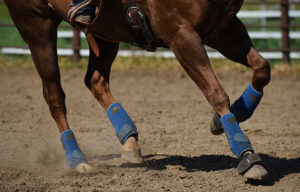Making Sure Your Horse Has Water During Severe Winter Storms
- Posted by Clair Thunes, PhD

Editor’s note: Texas experienced record-breaking winter weather and power outages in February 2021 that forced owners to get creative to ensure their horses had access to water. Read about their solutions in this reprint from February 22, 2021.
This past week, the news showcased tales of folks struggling through the aftereffects of two severe winter storms. While many northerly states in the U.S. experience such weather every year, these storms hit areas that rarely see such freezing temps. As a result, many people were unprepared and left without power or running water. The resulting primitive living would be a burden for just about anyone, but for those with horses and stock to manage, the situation was even more dire.
Most of us likely knew someone impacted by these storms, and certainly my social media feeds were filled with stories and images of folks doing the best they could in some very trying circumstances. As always, when you put humans in a seemingly impossible situation where the stakes are high, ingenuity reigns.
The bottom line is we all need water to survive, and horses need quite a lot of it. Estimates in the National Research Council’s (NRC) Nutrient Requirements of Horses state that an idle 500-kilogram (1,100-pound) mature horse needs anywhere from 5.5 to 9 gallons per day when the ambient temperature is 20 degrees Celsius (68 degrees Fahrenheit) and 12.5 gallons at -20 degrees Celsius (-4 degrees Fahrenheit). This increased need in cold weather can be due to the horses consuming more dry feed such as hay and less fresh grass if grass is under snow.
Couple the potentially greater need for water consumption with the conundrum that horses typically drink less water in colder weather. Research has shown that as water temperature fluctuates so does intake. Cold weather reduces intake, but so does drinking cold water versus warm water. Horses kept at ambient cool temperatures have been shown to drink 38 to 41% less water when that water is nearly frozen than when it is heated to an average of 19 degrees Celsius (66 degrees Fahrenheit).

With weather such as what Texans experienced this past week, these details pose a real problem. When you’re not normally impacted by such weather, chances are you’re not as prepared to deal with it as those who are more regularly hit by severe storms. So, if your well and pipes are frozen or you don’t have power to run the pump, what do you do? Sometimes, when the chips are down, you have to do things you wouldn’t typically consider. Here are some tactics folks have tried. Some worked, others did not.
Lighting fires under or in stock tanks
Social media has been filled with clever uses for barbecue coals for keeping water from freezing. Obviously, these tactics require great care but might be viable solutions in some situations. These range from placing a bar across a tank and suspending a metal bucket containing smoldering coals on top of the ice to melt a hole to raising a metal stock tank with bricks and lighting coals under it. The latter option might be best used for thawing a central source of water from which individual buckets can be filled so stock don’t have access to the hot coals. Those with stock ponds have been seen placing 50-gallon metal barrels on the ice and lighting fires inside to melt the pond ice around the barrel from which stock can then drink. If using this idea, do not place the barrel too far from shore. You only want a couple of inches of water under it. Drilling holes in the barrel might encourage air flow and keep coals smoldering.
Be very aware that winter vegetation is extremely dry and can catch fire easily, so consider where you place fires or burning coals, and monitor them closely.
Consider turning out your horses
This might seem counterintuitive, but if you have pastures with large stock tanks, they’ll take longer to freeze than small 5-gallon unheated buckets in stalls. Not only will your horse have longer access to unfrozen water, but you might be able to transport water to the larger troughs in a vehicle, reducing the amount of water you have to physically carry.
Floating items in the water
While floating a 2-liter soda bottled filled with salt water or tennis/soccer balls in a stock tank can help prevent freezing, in temperatures as low as those experienced in Texas last week, this option doesn’t work. Keep it up your sleeve for when temperatures are only slightly below freezing.

Bringing buckets of snow in the house to thaw
Though well pumps might not be running, if you have snow, you have water—just not in drinkable form. However, a 5-gallon bucket of snow does not yield a 5-gallon bucket of water, and it can take a surprisingly long time to melt, especially if your house isn’t well-heated. Firsthand reports indicate it takes about 5 buckets of snow to fill one 5-gallon bucket with water. While this might be feasible if you are managing one horse, for an entire barn this labor-intensive approach for such a low yield probably isn’t a great idea.
Catching snow melt
A better option than bringing snow into the house is to catch it as it melts off roofs. Even when ambient temperatures are below freezing, snow on rooves can start to melt when exposed to the sun. Line buckets up along the drip line or, if you have gutters, find buckets and barrels to put at the end of the down spouts. This option provided one barn of 14 horses and two show heifers with enough water over a five-day period while their well was offline. Editor’s note: Some states prohibit or limit “rainwater harvesting” and/or collecting water from roof surfaces. Check with your state’s water regulations.

Add molasses to water troughs
This option is potentially contentious, as many people have valid concerns about adding sugar to their horses’ diets. However, it is worth remembering that not all horses have metabolic issues, but all horses do need to drink water. Molasses has a freezing point well below 0 degrees Celsius (32 degrees Fahrenheit). Therefore, adding small amounts to water sources can help prevent ice formation. As little as ½ cup of molasses in 50 gallons of water might help prevent sheet ice from forming down to temperatures as low as -15 degrees Celsius (5 degrees Fahrenheit). The trick is to mix molasses with warm water first to create an emulsion. One friend who used this method successfully collected “warm” water from the well, added a few buckets of hot water, and piped that into the troughs containing the molasses emulsion. This method slowed freezing by several hours, and my friend had to fill the treated trough four times more frequently than untreated troughs.
For those concerned with sugar intake, some quick research and back-of-the-envelope math shows this molasses trick adds very little sugar. A half cup of molasses in 50 gallons has an estimated weight of 161 grams. Beet molasses is 50% sugar by dry weight (note that in this application it is used wet, so the sugar content per half cup is less). Therefore, the half cup of molasses adds no more than 80 grams of sugar to each 50 gallons. A horse consuming 10 gallons would, therefore, be consuming 16 grams of sugar. Compare that to feeding three peppermint candies, which provide 11 grams of sugar.

Bring horses in and offer them warmer water
If warmed water is unfeasible for all water supplies, consider using a water heater in the barn, warming small amounts, and rotating horses through to offer them warmed water.
Transporting water
If you don’t have large, enclosed containers for transporting water, line a 5-gallon bucket with a trash bag. Pour the water into the lined bucket and tie the bag off. Leave the bag in the bucket. This prevents water from slopping out of buckets as you carry or drive it to its destination.
Conclusion
In situations such as those many experienced this past week, you have to make the best of a bad hand and make do with what’s available. Educate yourself of the signs of dehydration in your horses, and check them often to make sure they’re drinking enough.

Written by:
Clair Thunes, PhD
Related Articles
Stay on top of the most recent Horse Health news with












One Response
The tip for transporting full buckets of water is brilliant!